Abstract
Nanosized V-Ce oxides supported on TiO2 (VCT) were prepared and utilized in the low-temperature selective catalytic reduction (SCR) of NO with NH3. Compared with the other V-Ce oxides-based catalysts supported on Al2O3, ZrO2, and ZSM-5, VCT showed the best SCR activity in a low-temperature range. The NOx conversion of 90% could be achieved at 220 °C. Characterizations including X-ray diffraction (XRD), scanning election micrograph (SEM), transmission electron microscopy (TEM), X-ray photoelectron spectroscopy (XPS), temperature-programmed desorption with NH3 (NH3-TPD), and temperature-programmed reduction with H2 (H2-TPR) showed that V1.05Ce1/TiO2 exhibited a good dispersion of V2O5, enrichment of surface Ce3+ and chemical-absorbed oxygen, and excellent redox capacity and acidity, which resulted in the best SCR performance at low temperature.
1. Introduction
Nitrogen oxides (NOx), as one of the main pollutants in the atmosphere, give rise to many environmental problems such as acid rain, photochemical pollution, and haze [1,2,3]. The selective catalytic reduction (SCR) of NOx with NH3 is a relatively mature technique for NOx abatement from thermal power plants, chemical plants, etc. [4,5], and the deNOx catalyst is the key factor for the technique [6]. Currently, V2O5-WO3/TiO2 and V2O5-MoO3/TiO2 are the most widely used catalysts for NOx removal because of their high activity and N2 selectivity [7], but a series of problems still existed, such as the relatively narrow working temperature range of 300–420 °C [8], the high oxidation ratio of SO2 to SO3 [5,9], the toxicity of vanadium species [10], and the formation of N2O at relatively high temperatures [11]. As such, the application of SCR technology in waste incinerators, industrial boilers, as well as biomass fuel power plants has been hindered.
In view of the defects above, much attention has been put into developing efficient SCR catalyst working in low-temperatures or wide range temperatures. Meanwhile, researchers have been working on low vanadium catalysts in recent years, and excellent NOx conversion has been achieved on supported V2O5 catalysts [12,13,14], but several problems still remain, especially for N2 selectivity. Since CeO2 has predominant oxygen storage/release ability and good redox property [15,16,17,18], it was regarded as a critical component of efficient catalysts for SCR. However, pure CeO2 was rarely used alone as an active component in reaction duo to its poor NH3 adsorption capacity and high reaction temperature [19]. Nowadays, more and more studies choose CeO2 as a main modifier or the secondary elements were dropped into CeO2 to enhance the SCR activity [10,20,21]. Based on the traditional catalysts V2O5-WO3(MoO3)/TiO2, V-Ce mixed oxides-based catalysts such as V2O5-CeO2/SiO2 [22], V2O5-CeO2/TiO2-ZrO2 [23], and V2O5-CeO2/WO3-TiO2 [24] with high activity at 200–420 °C were developed, and they showed quite different catalytic performances in SCR reaction. However, the detail information including physicochemical properties of V-Ce mixed oxides catalysts over various structures is limited, and the catalytic performance of V-Ce mixed oxides catalysts at low temperatures should be further enhanced.
Generally, the support materials will have an important impact on the performance of SCR catalysts due to the structure/texture and acid/redox properties, the inherent catalytic nature of materials, and the metal–support interaction [25]. Some support materials such as TiO2, ZrO2, Al2O3, and ZSM-5 can be used for the NH3-SCR reaction. Among these oxides, TiO2 shows a large amount of acid sites on the surface but with low surface areas; ZrO2 exhibits special characteristics, such as high thermal stability, extreme hardness, and excellent activity at high temperatures, but the activity is poor at low temperatures; γ-Al2O3 is a porous solid material with a high specific surface area but shows an obvious inhibition on the SCR reaction in the presence of SO2 and H2O [26]; ZSM-5 is porous and shows a high specific surface area but with low acid sites and adsorption capacity.
On the basis of these factors, in this paper, nanosized V-Ce oxides supported on TiO2 were studied. A series of characterization methods, such as Brunauer-Emmett-Teller (BET) specific surface area and Pore size distributions employing the Barrett-Joyner-Halenda (BJH) model (BET-BJH), scanning election micrograph (SEM), transmission electron microscopy (TEM), X-ray diffraction (XRD), X-ray photoelectron spectroscopy (XPS), temperature-programmed reduction with H2 (H2-TPR) and temperature-programmed desorption with NH3 (NH3-TPD) were conducted to explore the activity of catalysts in SCR reaction, expecting to get the V-Ce catalysts with better catalytic performance and broad application prospect at low temperatures for SCR.
2. Results and Discussion
2.1. Morphology and Structure Investigations
XRD was utilized to determine the bulk crystalline phases in the samples. The XRD results of different catalysts were shown in Figure 1. For the samples of V-Ce oxides supported on TiO2 (VCT), Al2O3 (VCA), ZrO2 (VCZR) and ZSM-5 (VCZS), most of the strongest peaks in each XRD patterns belonged to their supports, respectively. Among them, the anatase phase (PDF-#21-1272) dominated on VCT and traces of rutile (PDF-#21-1276) phase were also detected, which may resulted from P25 (a precursor of TiO2) containing about 20% rutile phase. For VCT, VCA, and VCZS, the diffraction peaks of cubic CeO2 (PDF-#34-0394) were also found, and the diffraction peak of cubic CeO2 in VCA was much stronger than that in VCT and VCZS, which indicated its high crystallinity. The peak assigned to V2O5 was absent in any of the catalysts during XRD analysis, suggesting that V species were highly dispersed and existed in an amorphous state throughout the support structure [27].
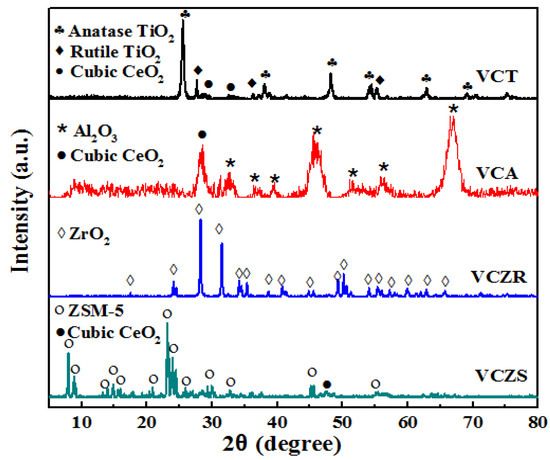
Figure 1.
X-ray diffraction patterns of different samples.
The HR-TEM and SEM-EDS mapping results of VCT were plotted in Figure 2. As shown in Figure 2a,b, the lattice fringes of both cubic CeO2 (111) and (1-1-1) crystal planes with an interplanar spacing of 0.32 nm and 0.31 nm were well-defined in the sample of VCT [28], which was consistent with the observation from XRD results. In addition, the SEM-EDS mapping of Ce, V, Ti, and O elements on the VCT were detected in Figure 2c,d, and it was obvious to notice that all the elements mentioned above were uniformly distributed. Meanwhile, the textural properties of different samples were measured, and the corresponding results were displayed in Table 1. The BET specific surface area of all the catalysts decreased as VCZS > VCA > VCT > VCZR. Among the samples, VCZS exhibited better structure, including the largest BET specific surface area (334.4 m2/g) but with smaller pore volume (0.20 cm3/g) while VCT showed lower BET specific surface area (53.0 m2/g) but with higher pore volume (0.86 cm3/g). The largest BET specific surface area of VCZS could mainly attribute to the property of ZSM-5. It was worth noticing that the textural properties of different catalysts did not match with the XRD results, which demonstrated the better morphology of VCT. Even though a larger surface area facilitated the adsorption and activation of reactants during reaction, it may not be the determining factor affecting the catalytic performance in this study. Further correlation between the structural properties and activity would be discussed in the section of catalytic performance.
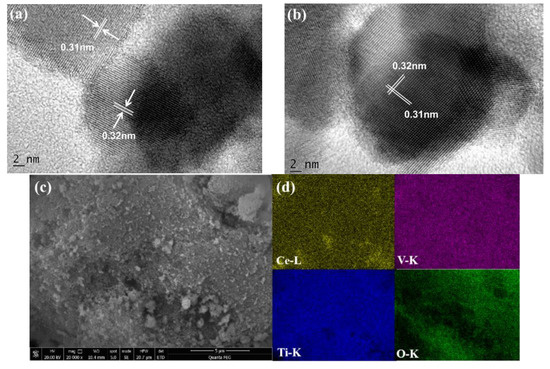
Figure 2.
HR-TEM image (a,b) and SEM-EDS mapping images (c,d) of V-Ce oxides supported on TiO2 (VCT).

Table 1.
Textural properties of different samples.
2.2. Surface Analysis
Figure 3 showed the O 1s XPS spectra of different catalysts. The O 1s peaks could be separated into three peaks: the peaks at lower binding energies (529.3–530 eV) are attributed to the lattice oxygen (hereafter denoted as Oβ), the peaks at binding energies (530.1–532 eV) are related to the chemical adsorbed oxygen (hereafter denoted as Oα), and the peaks at higher binding energies (532.8–533 eV) are related to the hydroxyl oxygen (hereafter denoted as Oγ) [29,30]. Chemical adsorbed oxygen always exhibit better catalytic activity than lattice oxygen and hydroxyl oxygen, and it plays an important part in SCR reaction because of its higher mobility. Meanwhile, it can improve the catalytic performance by facilitating the NO oxidation to NO2 by a fast SCR reaction [31,32]. Thus, the Oα ratio, calculated by Oα/(Oα + Oβ + Oγ), was listed in Table 2 to analyze the catalytic performance of different catalysts. From the results of XPS analysis, VCT and VCA showed similar Oα concentration with the Oα/(Oα + Oβ + Oγ) ratio of 36% and 37%, while VCZR and VCZS were 32% and 5%, respectively. For VCZS, the peak that appeared at 532.8 eV binding energy could be attributed to Oγ, which took up 89% of the oxygen state and it mainly came from the ZSM-5 support, while the Oα ratio in VCZS was only 5% during the XPS analysis. The higher Oα ratio over catalyst was essential for their catalytic performance in SCR reaction. All the differences from four catalysts could be explained by the characteristics of different supports as well as the formation of interaction between active components and supports. Other chemical elements could not be ignored and also tested for further investigation to get comprehensive consideration.
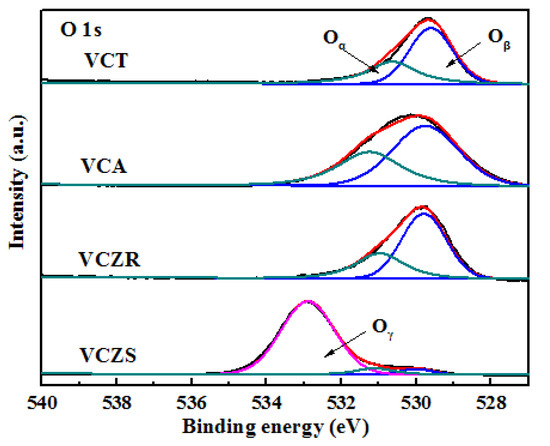
Figure 3.
O 1s X-ray photoelectron spectroscopy (XPS) high-resolution scans spectra of different samples.

Table 2.
Surface composition of the samples obtained by XPS.
Figure 4 showed the Ce 3d XPS spectra of different catalysts. The complex spectrum of Ce 3d was decomposed into eight components. These peaks labeled u and v were attributed to the spin-orbit components of the Ce 3d3/2 and Ce 3d5/2, respectively. The peaks labeled u‴, u″, u, v‴, v″, and v represent the 3d104f0 state of Ce4+, while the bands labeled u′ and v′ represent the 3d104f1 initial electronic state corresponding to Ce3+ [33,34]. The XPS spectra indicated the coexistence of Ce3+ and Ce4+ species over all the catalysts, and the Ce element mainly existed in the form of CeO2. The coexistence of Ce4+ and Ce3+ was beneficial to the catalytic activity because of its coherent ability to increase the amount of chemical adsorbed oxygen on the catalyst surface [35]. Table 2 was applied to calculate the surface Ce3+/(Ce3+ + Ce4+) atomic ratios. Among them, VCT showed the highest Ce3+/(Ce3+ + Ce4+) atomic ratios of 36%, while VCA, VCZR and VCZS catalysts were calculated at 29%, 27%, and 26%, respectively. As we know, Ce3+ came from the ceria defects and was accompanied by the formation of oxygen vacancies; Ce3+ and oxygen vacancies can lead to charge imbalance, form an unsaturated chemical bond, promote the adsorption of free oxygen, and enhance the repeatable Ce4+/Ce3+ redox cycles in the final and thus facilitated the NH3-SCR reaction [36]. The promotion effect came from Ce4+/Ce3+ redox cycles for SCR reaction became more obvious on the VCT sample.
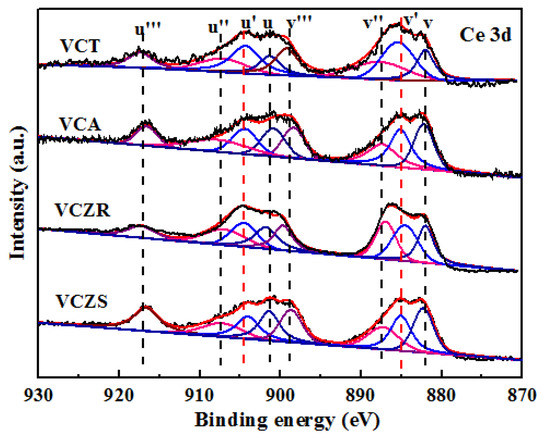
Figure 4.
Ce 3d XPS high-resolution scans spectra of different samples.
Figure 5 showed the V 2p XPS spectra of different catalysts. The V 2p peaks could be separated into two peaks: the peaks at binding energies 515.6–516.5 eV and 523.5 eV are attributed to V4+, while the peaks at binding energies 516.8–517.7 eV and 524.8 eV are attributed to V5+ [37,38,39]. The proportions of V4+/(V4+ + V5+) on different catalysts were calculated, and the results are listed in Table 2. VCT achieved the highest V4+/(V4+ + V5+) atomic ratios of 51% when compared with that in VCA, VCZS, and VCZR at 44%, 36%, 36%, respectively. It was reported that V4+ species in V2O5 exist with oxygen defects, while the redox cycles of V5+/V4+ will be prohibited once the amount of V4+ species decreased or disappeared, which will have a negative impact on the redox properties of catalysts [40]. The coexistence of V4+ and V5+ can generate the unsaturated valence of V to accelerate the adsorption of oxygen and generate active oxygen species. The higher V4+/(V4+ + V5+) atomic ratios in VCT provided the main active valence state of V4+ and it was beneficial for the SCR process.
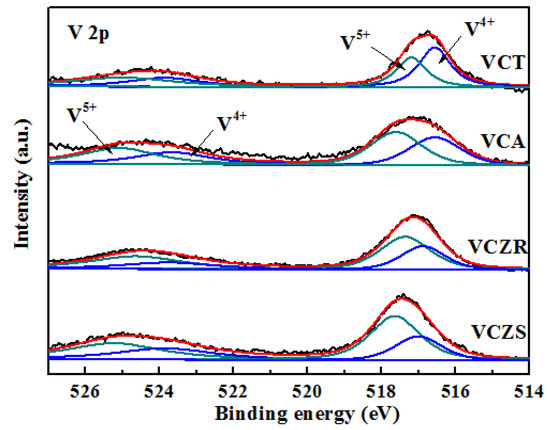
Figure 5.
V 2p XPS high-resolution scans spectra of different samples.
2.3. Reducibility
To investigate the reduction behavior of different catalysts, H2-TPR analysis were performed and the results are illustrated in Figure 6. After a peak-fitting deconvolution, the catalysts displayed three peaks at 400–500 °C, 500–600 °C, and 600–720 °C. The first intensity peaks on VCT, VCZS, VCA, and VCZR were observed at 427 °C, 465 °C, 499 °C, and 566 °C, respectively; they belonged to the reduction of CeO2 on surface and may overlap the reduction peaks of V oxides [41]. It was reported that the lower the reaction peak appeared, the stronger the reducibility was; VCT showed a peak at 427 °C prior to others. The second peaks on VCT, VCZS, and VCA were observed at 500–600 °C, which indicated that various strong interaction between V-Ce mixed oxides on different supports were generated and formed intermediate oxides. The peaks over 600 °C could belong to the reduction of bulk CeO2 [42], especially for VCZR and VCZS with higher temperature, indicating the difficulty of bulk CeO2 reduction due to its high crystallinity. Moreover, H2 consumption was used to analyze the oxygen storage capacity of catalysts, which was a crucial parametric for ceria-based catalysts in SCR reaction [43]. As shown in Figure 6, it was found that H2 consumption on VCT (542 μmol/g) was a little higher than others. The patterns in different shapes of catalysts could be ascribed to effect resulting from the interaction between active components and various supports, which may be the key factors of different catalysts in the improvement of SCR activity at low temperature.
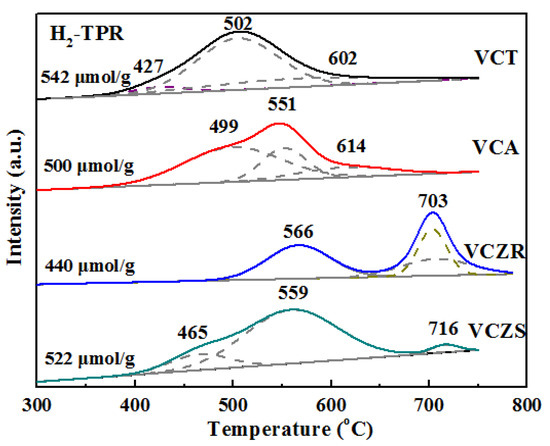
Figure 6.
Temperature-programmed reduction with H2 (H2-TPR) profiles of different samples.
2.4. Surface Acidity
The adsorption and activation of NH3 species on catalyst surface is a key step in NH3-SCR reaction, which is greatly affected by the number and strength of the acid sites on the catalyst surface [44]. Therefore, the adsorption behavior of NH3 on four catalysts was investigated by NH3-TPD analysis, as presented in Figure 7. VCZR processed two desorption peaks while VCT, VCA, and VCZS processed three desorption peaks. In terms of VCT, VCA, and VCZS, the peaks “I”, “II”, and “III” were attributed to the NH3 desorption of weak acid sites, medium acid sites, and strong acid sites [39,45]. For VCZR, the peak attributed to the NH3 desorption of medium acid sites was absent. It was reported that NH3 bound to Brønsted acid sites are less thermally stable than the NH3 molecules bound to Lewis acid sites and could desorb at lower temperatures [46]. In this work, except for VCZR, the peaks “I” and “II” range from 120 to 250 °C at lower temperature and resulted from the NH3 bound to Brønsted acid sites, while the peaks “III” over 300 °C at higher temperature were ascribed to the NH3 desorption bound to Lewis acid sites. The peaks on VCZS shifted significantly to higher temperatures than others. To get further discussion, the quantitative analysis of NH3-TPD over different samples were also obtained and shown in Table S2. The total amount of adsorbed NH3 was decreased as follows: VCT (2990) > VCA (2830) > VCZS (2030) > VCZR (1750). VCT showed the higher total amount of adsorbed NH3 as well as NH3 adsorption capacity at Brønsted acid sites than others, which may be attributed to their better SCR performance.
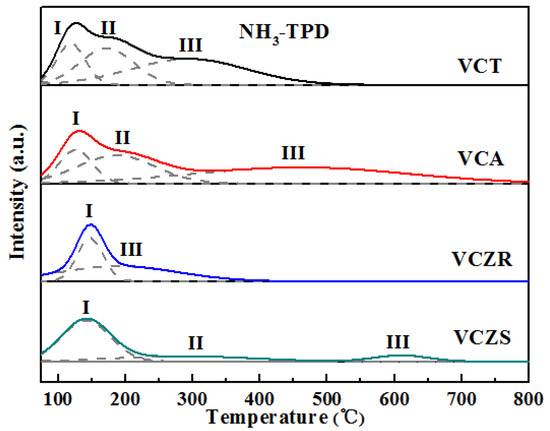
Figure 7.
Temperature-programmed desorption with NH3 (NH3-TPD) profiles of different samples.
2.5. Catalytic Performance
Figure 8 demonstrated the results of the catalytic performances of nanosized V-Ce based materials for NH3-SCR reaction. As shown in Figure 8, NOx conversion of SCR catalysts at low temperatures decreased in the following order VCT > VCZR > VCA > VCZS, which may be related with the inherent nature of each support and its interaction with V-Ce mixed oxides. It was interesting to find that VCZR exhibited high catalytic activity at 300 °C, but the NOx conversion started to decrease sharply as soon as the temperature increased over 300 °C. VCA and VCZS all had a wide active temperature window, but their catalytic performances was not obvious at low temperatures and much lower than VCT and VCZR. Compared with others, VCT exhibited the highest SCR activity at the low temperature range of 150–300 °C, over which about 90% NOx conversion was achieved at 220 °C and a NOx conversion of 100% at 265 °C could be observed, which showed the best catalytic performance for V-Ce mixed oxides on TiO2 support at low temperatures. The better catalytic performance on VCT was well matched with the XPS and H2-TPR results. Meanwhile, in view of the decrease of NOx conversion in the order of VCT > VCZR > VCA > VCZS and combined with the decrease of BET specific surface area in the order of VCZS > VCA > VCT > VCZR, the results further demonstrated the catalytic performance on catalysts were less related with their structural properties.
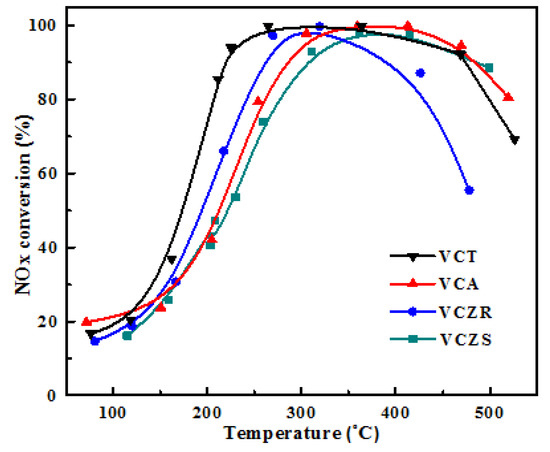
Figure 8.
Nitrogen oxides (NOx) conversion with reaction temperature over different samples (Reaction conditions: NO = NH3 = 700 ppm, O2 = 3%, balance N2, 0.5 g catalyst and gas hourly space velocity (GHSV) about 50,000 h−1).
N2O (a potential by-product of the SCR reaction) was detected and shown in Figure 9. It could be seen that the N2O concentration of all samples was negligible below 300 °C. When the reaction temperature increased over 300 °C, the N2O concentration of various catalysts increased with different speed. VCT had better N2 selectivity with a low N2O concentration of 50 ppm before 350 °C, while it converted to the fastest growth rate at higher temperatures. Meanwhile, Figure 10 showed the NH3 oxidation rate of different catalysts and various products, including NO, NO2, and N2O, were also tested. Initially, the NH3 oxidation rate was almost consistent with NOx conversion and the significant conversion occurred after 250 °C, especially for VCT and VCZR, which was facilitated for the SCR process to promote the reduction of NOx. Combined with Figure 9, the N2O concentration over all the catalysts in NH3 oxidation reaction was consistent with that in SCR reaction before 300 °C, but the N2O concentration in SCR reaction exceeded that in NH3 oxidation reaction as the temperature increased over 300 °C. VCT showed poor N2 selectivity at high temperature, and the increasing N2O concentration was mainly caused by unselective NH3 oxidation. Many studies also demonstrated that excessive NH3 oxidation could decrease the catalytic activity and N2 selectivity at high temperatures [47].
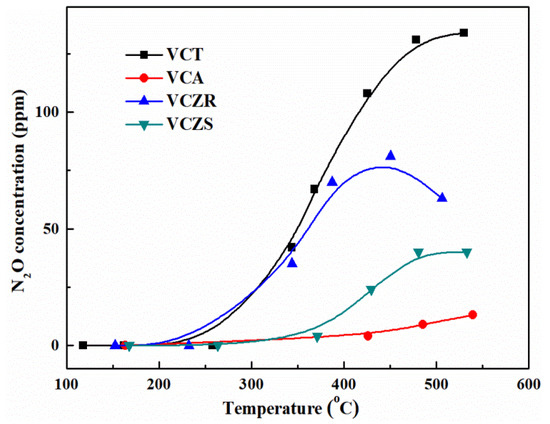
Figure 9.
N2O concentration with reaction temperature over different samples (reaction conditions: NO = NH3 = 700 ppm, O2 = 3%, balance N2, 0.5 g catalyst, and GHSV about 50,000 h−1).
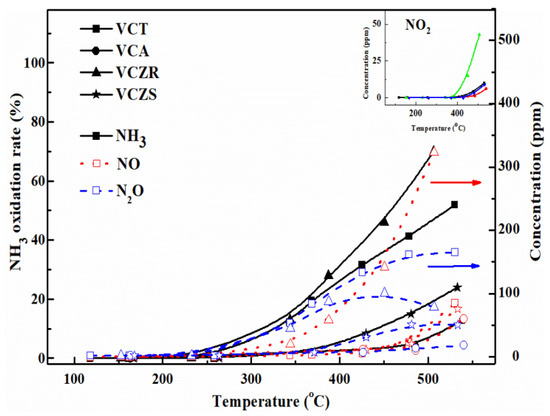
Figure 10.
NH3 oxidation and concentration profile of NO, N2O over different samples (reaction conditions: NH3 = 700 ppm, O2 = 3%, balance N2, 0.5 g catalyst, and GHSV about 50,000 h−1).
In short, the catalytic properties of catalysts were influenced by many parameters. By integration of all the factors mentioned above into consideration, the VCT exhibited outstanding catalytic performance at low temperatures. According to TEM and EDS mapping results, nanosized V-Ce oxides supported on TiO2 led to a good dispersion of all the elements and avoided the aggregation of species on catalysts. Together, it was reported that TiO2 could promote the formation of active Ce3+ species to some extent [38]. In our study, the redox cycles was promoted with higher chemical-absorbed oxygen, Ce3+, and V4+ atomic ratios on the surface of VCT, and this result was consistent with the better catalytic performance on VCT. Furthermore, it was demonstrated H2-TPR and NH3-TPD were strongly related with the nature of support oxide, and TiO2 provided more interaction between active species and support than others, which was mainly represented by a better reduction property and an increased quantity of acid sites. All of above may be contributors to VCT with the highest catalytic performance in SCR reaction.
3. Materials and Methods
3.1. Catalyst Preparation
The catalysts were prepared by the wet impregnation method. Ammonium metavanadate and cerium nitrate were used as precursors with a molar ratio of 1.05:1 (V2O5 mass ratio of 5% in the catalyst) were completely dissolved in saturated oxalic acid solution and stirred for 3 h to form a mixed solution. Under the agitation, the mixed solution was added into TiO2 (P25), which dissolved in deionized water. After being dried at 110 °C for 12 h, the samples were calcined at 500 °C for 3 h. The prepared V-Ce catalyst supported on TiO2 was named as VCT. For the comparison, V-Ce oxides-based catalysts supported on Al2O3, ZrO2, and ZSM-5 were also prepared, and they were named as VCZR, VCA, VCZS, respectively.
3.2. SCR Activity Experiments and Measurement
The NH3-SCR activity and N2O concentration were carried out in a micro catalytic reactor, which consists of a mass flow meter, a reaction gas mixer, and a fixed bed reactor with a 1 cm inner diameter, containing 0.5 g of the catalyst. The reaction conditions were as follows: 700 ppm NO (when used), 700 ppm NH3 (when used), 1.5% H2O (when used), 3% O2, and N2 in balance with gas hourly space velocity (GHSV) of 50,000 h−1 for this system. The concentrations of the reactants and products were measured as follows: inlet and outlet NOx concentrations were analyzed using a NOx analyzer (ECOMD, rbr Messtechnik GmbH, Germany), and N2O concentrations were analyzed using a N2O analyzer (G200, Geotechnical Instruments Ltd., Coventry, UK).
Independent NH3 oxidation experiments were also carried out in a micro catalytic reactor, containing 0.5 g of the catalyst. The reaction conditions were as follows: 700 ppm NO, 700 ppm NH3, 1.5% H2O (when used), 3% O2 and N2 in balance with GHSV of 50,000 h−1 for this system. The concentrations of NH3 were detected by a FT-IR gas analyzer (Gasmet DX-4000, Temet Instrument Oy, Helsinki, Finland).
The NOx conversion in SCR reaction was calculated as:
NOx conversion (%) = 100% × (NOx(in) − NOx(out))/NOx(in)
The NH3 oxidation rate was calculated as:
NH3 oxidation (%) = 100% ×(NO(out) + NO2(out) + 2N2O(out))/NH3(in)
3.3. Catalyst Characterization
The Brunauer-Emmett-Teller (BET) specific surface area (SBET) was determined by a multipoint BET method using the adsorption data in the relative pressure (P/P0) range from 0.05 to 0.30 and the pore size distributions were calculated by employing the Barrett-Joyner-Halenda (BJH) model on ASAP 2020 (Micromeritics Corporation, Atlanta, GA, USA) The samples were pretreated for 4 h under vacuum conditions at 400 °C to pure the surface before measurements.
The micrograph structures of the samples were observed by scanning election micrograph on a FEI XL30 ESEM (FEI Inc. Phillips, Hillsboro, Oreg., USA), and the morphology of the samples were detected by transmission electron microscopy (TEM, JEM-2010, JEOL Ltd., Tokyo, Japan) with energies of 200 eV.
X-ray diffraction (XRD) patterns were recorded on an X-ray diffractometer (model D/max RA, Rigaku Corporation, Tokyo, Japan) with Cu Kα radiation (λ = 0.15418 nm), which was used to investigate the crystal phases of the samples and the information was obtained with scattering angles (2θ) ranging from 10° to 80° at a step rate of 10° min−1 with a step size of 0.02.
X-ray photoelectron spectroscopy (XPS) analysis was recorded on ESCALAB 250Xi (Thermo Fisher Scientific, Waltham, USA) with Al Ka radiation (hv = 1486.6 eV, λ = 500 μm) operated at 150 W to investigated the chemical valence state distribution and the proportions of surface elements. The spectra were recorded in the fixed analyzer transmission mode with energies of 20 eV. The shift of the binding energy due to relative surface charging was corrected using the C 1s level at 284.8 eV as an internal standard. The C 1s high-resolution scans spectra of different samples are shown in Figure S1. Deconvolution was performed with the XPS peak program, and the spectra were decomposed with the least squares fitting routine provided with the software with Gaussian/Lorentzian (80/20) product function and after subtracting the background. Atomic fractions were calculated using peak areas normalized on the basis of sensitivity factors.
Temperature-programmed desorption with NH3 (NH3-TPD) and temperature-programmed reduction with H2 (H2-TPR) experiments were carried out on a MicroActive for autoChem II 2920 (Micromeritics Corporation, Atlanta, GA, USA). Prior to the NH3-TPD experiments, samples were purified in He at 200 °C for 1 h and cooled down to 50 °C; then, they were saturated with 5% NH3/He at room temperature. Desorption was conducted by heating the samples with the heating rate of 10 °C/min from 50 to 800 °C. With respect to H2-TPR experiments, samples were purified in pure He at 200 °C for 1 h and then cooled to 50 °C. Then, the H2-TPR experiment was carried out with the linear heating rate of 10 °C/min from 50 to 800 °C in 10% H2/Ar.
4. Conclusions
In this work, nanosized V-Ce oxides supported on TiO2 was performed and used for the SCR of NO with NH3. The V1.05Ce1/TiO2 (VCT) catalyst showed the superior catalytic activity at low temperature when compared with VCA, VCZR, and VCZS. The NOx conversion of 100% could be achieved on VCT at 250 °C. The underlying reasons for catalytic activity between various catalysts were systematically investigated by characterization methods. In the XRD patterns, the anatase phase was the main phase, and the peak assigned to V2O5 was absent in VCT, which clearly indicated the strong dispersion of V2O5. XPS analysis revealed that VCT was of the higher Oα, Ce3+, and V4+ concentrations, processing higher oxygen mobility and facilitating for the redox process. The NH3-TPD indicated that VCT had strong adsorption capacity with more surface acid sites. In addition, H2-TPR showed a reduction peak for VCT at low temperatures, which revealed that the nanosized V-Ce oxides supported on TiO2 had excellent redox property. In conclusion, all characterization results proved that there was a good dispersion of V2O5, and the results may provide useful information for the design of nanosized V-Ce oxides-based catalysts.
Supplementary Materials
The following are available online at https://www.mdpi.com/2073-4344/10/2/202/s1, Table S1: The relative atomic ratio of O elements over different samples obtained by XPS, Table S2: Quantitative analysis of NH3-TPD over different samples, Figure S1(a–d). The C 1s high-resolution scans spectra of different samples.
Author Contributions
Conceptualization, C.H., X.C. and C.C.; Data Curation, L.L.; Investigation, X.W.; Methodology, Y.L.; validation, P.F. and D.C.; writing–original draft preparation, X.W.; writing–review and editing, X.C. and C.C. All authors have read and agreed to the published version of the manuscript.
Funding
This research was funded by Key-Area Research and Development Program of Guangdong Province (2019B110209003), the National Natural Science Foundation of China (41663002), the Natural Science Foundation of Jiangxi Province (20161BAB203080), Jiangxi Institute of Hydraulic Research (20192BAB213027), National Key Research and Development Plan (2016YFC0204101), the Science and Technology Key Projects of Guangdong Province(2017A030223005), the Science and Technology Program of Guangzhou City (201804010147), Pearl River S&T Nova Program of Guangzhou, China (201710010133), and the Central-Level Nonprofit Scientific Institutes for Basic R&D Operations (PM-zx703-201803-077).
Conflicts of Interest
The authors declare no conflict of interest.
References
- Han, L.; Cai, S.; Gao, M.; Hasegawa, J.-Y.; Wang, P.; Zhang, J.; Shi, L.; Zhang, D. Selective Catalytic Reduction of NOx with NH3 by Using Novel Catalysts: State of the Art and Future Prospects. Chem. Rev. 2019, 119, 10916–10976. [Google Scholar] [CrossRef]
- Kwon, D.W.; Park, K.H.; Ha, H.P.; Hong, S.C. The role of molybdenum on the enhanced performance and SO2 resistance of V/Mo-Ti catalysts for NH3-SCR. Appl. Surf. Sci. 2019, 481, 1167–1177. [Google Scholar] [CrossRef]
- Li, J.; Chen, R.; Cen, W.; Yan, P.; Li, K.; Wang, P.; Shu, S.; Chu, Y.; Dong, F. Quantifying the activation energies of ROS-induced NOx conversion: Suppressed toxic intermediates generation and clarified reaction mechanism. Chem. Eng. J. 2019, 375, 122026. [Google Scholar] [CrossRef]
- Yu, Y.; Wang, J.; Chen, J.; Meng, X.; Chen, Y.; Chi, H. Promotive Effect of SO2 on the Activity of a Deactivated Commercial Selective Catalytic Reduction Catalyst: An in Situ DRIFT Study. Ind. Eng. Chem. Res. 2014, 53, 16229–16234. [Google Scholar] [CrossRef]
- Kwon, D.W.; Kim, J.; Ha, H.P. Establishment of surface/bulk-like species functionalization by controlling the sulfation temperature of Sb/V/Ce/Ti for NH3-SCR. Appl. Surf. Sci. 2019, 481, 1503–1514. [Google Scholar] [CrossRef]
- Liu, Z.; Zhang, S.; Junhua, L.I.; Zhu, J.; Lingling, M.A. Novel V2O5-CeO2/TiO2 catalyst with low vanadium loading for the selective catalytic reduction of NOx by NH3. Appl. Catal. B 2014, 158–159, 11–19. [Google Scholar] [CrossRef]
- Geng, Y.; Jin, K.; Mei, J.; Su, G.; Ma, L.; Yang, S. CeO2 grafted with different heteropoly acids for selective catalytic reduction of NOx with NH3. J. Hazard. Mater. 2019, 382, 121032–121043. [Google Scholar] [CrossRef]
- Silas, K.; Ghani, W.A.W.A.K.; Choong, T.S.Y.; Rashid, U. Breakthrough studies of Co3O4 supported activated carbon monolith for simultaneous SO2/NOx removal from flue gas. Fuel Process. Technol. 2018, 180, 155–165. [Google Scholar] [CrossRef]
- Lian, Z.; Liu, F.; Hong, H. Enhanced Activity of Ti-Modified V2O5/CeO2 Catalyst for the Selective Catalytic Reduction of NOx with NH3. Ind. Eng. Chem. Res. 2014, 53, 19506–19511. [Google Scholar] [CrossRef]
- Yao, W.; Wang, X.; Liu, Y.; Wu, Z. Ce-O-P material supported CeO2 catalysts: A novel catalyst for selective catalytic reduction of NO with NH3 at low temperature. Appl. Surf. Sci. 2019, 467–468, 439–445. [Google Scholar] [CrossRef]
- Zhang, Z.; Chen, L.; Li, Z.; Li, P.; Yuan, F.; Niu, X.; Zhu, Y. Activity and SO2 resistance of amorphous Ce-TiOx catalysts for the selective catalytic reduction of NO with NH3: In Situ DRIFT studies. Catal. Sci. Technol. 2016, 6, 7151–7162. [Google Scholar] [CrossRef]
- Vuong, T.H.; Radnik, J.; Kondratenko, E.; Schneider, M.; Armbruster, U.; Brückner, A. Structure-reactivity relationships in VOx/CexZr1−xO2 catalysts used for low-temperature NH3-SCR of NO. Appl. Catal. B 2016, 197, 159–167. [Google Scholar] [CrossRef]
- Ma, J.; Liu, Z.; Liu, Q.; Guo, S.; Huang, Z.; Xiao, Y. SO2 and NO removal from flue gas over V2O5/AC at lower temperatures—Role of V2O5 on SO2 removal. Fuel Process. Technol. 2008, 89, 242–248. [Google Scholar] [CrossRef]
- Chen, H.; Xia, Y.; Fang, R.; Huang, H.; Gan, Y.; Liang, C.; Zhang, J.; Zhang, W.; Liu, X. The effects of tungsten and hydrothermal aging in promoting NH3-SCR activity on V2O5/WO3-TiO2 catalysts. Appl. Surf. Sci. 2018, 459, 639–646. [Google Scholar] [CrossRef]
- Andreoli, S.; Deorsola, F.A.; Pirone, R. MnOx-CeO2 catalysts synthesized by solution combustion synthesis for the low-temperature NH3-SCR. Catal. Today 2015, 253, 199–206. [Google Scholar] [CrossRef]
- Yang, Y.; Liu, J.; Wang, Z.; Liu, F. A skeletal reaction scheme for selective catalytic reduction of NOx with NH3 over CeO2/TiO2 catalyst. Fuel Process. Technol. 2018, 174, 17–25. [Google Scholar] [CrossRef]
- Cheng, H.; Tan, J.; Ren, Y.; Zhao, M.; Liu, J.; Wang, H.; Liu, J.; Zhao, Z. Mechanochemical Synthesis of Highly Porous CeMnOx Catalyst for the Removal of NOx. Ind. Eng. Chem. Res. 2019, 58, 16472–16478. [Google Scholar] [CrossRef]
- Sun, X.; Guo, R.-T.; Liu, S.-W.; Liu, J.; Pan, W.-G.; Shi, X.; Qin, H.; Wang, Z.-Y.; Qiu, Z.-Z.; Liu, X.-Y. The promoted performance of CeO2 catalyst for NH3-SCR reaction by NH3 treatment. Appl. Surf. Sci. 2018, 462, 187–193. [Google Scholar] [CrossRef]
- Yang, S.; Guo, Y.; Chang, H.; Ma, L.; Peng, Y.; Qu, Z.; Yan, N.; Wang, C.; Li, J. Novel effect of SO2 on the SCR reaction over CeO2: Mechanism and significance. Appl. Catal. B 2013, 136, 19–28. [Google Scholar] [CrossRef]
- Wang, Z.; Lin, F.; Jiang, S.; Qiu, K.; Kuang, M.; Whiddon, R.; Cen, K. Ceria substrate–oxide composites as catalyst for highly efficient catalytic oxidation of NO by O2. Fuel 2016, 166, 352–360. [Google Scholar] [CrossRef]
- Jiang, S.-Y.; Zhou, R.-X. Ce doping effect on performance of the Fe/β catalyst for NOx reduction by NH3. Fuel Process. Technol. 2015, 133, 220–226. [Google Scholar] [CrossRef]
- Sohot, M.R.; Jais, U.S.; Sulaiman, M.R. Microstructure of Porous V2O5-CeO2-SiO2 Catalyst for SCR of NO with NH3 at Low Temperature. Adv. Mater. Res. 2014, 875–877, 213–217. [Google Scholar] [CrossRef]
- Zhang, Y.; Guo, W.; Wang, L.; Min, S.; Yang, L.; Kai, S.; Xu, H.; Zhou, C. Characterization and activity of V2O5-CeO2/TiO2-ZrO2 catalysts for NH3 selective catalytic reduction of NOx. Chin. J. Catal. 2015, 36, 1701–1710. [Google Scholar] [CrossRef]
- Shen, M.; Xu, L.; Wang, Q. Effect of synthesis methods on activity of V2O5/CeO2/WO3-TiO2 catalyst for selective catalytic reduction of NOx with NH3. J. Rare Earths 2016, 34, 259–267. [Google Scholar] [CrossRef]
- Yang, P.; Fan, S.; Chen, Z.; Bao, G.; Zuo, S.; Qi, C. Synthesis of Nb2O5 based solid superacid materials for catalytic combustion of chlorinated VOCs. Appl. Catal. B 2018, 239, 114–124. [Google Scholar] [CrossRef]
- Chen, H.; Li, H. Denitration performance of supported Mn-Fe/γ-Al2O3 catalyst at low temperature. Chem. Ind. Eng. Prog. 2016, 35, 1107–1112. [Google Scholar]
- Wang, H.; Chen, X.; Gao, S.; Wu, Z. Deactivation mechanism of Ce/TiO2 selective catalytic reduction catalysts by the loading of sodium and calcium salts. Catal. Sci. Technol. 2013, 3, 715–722. [Google Scholar] [CrossRef]
- Yin, M.; Qiu, W.; Song, L.; Zhu, H. Promoting Effect of Organic Ligand on the Performance of Ceria for the Selective Catalytic Reduction of NO by NH3. ChemistrySelect 2018, 3, 2683–2691. [Google Scholar] [CrossRef]
- Huang, X.; Zhang, G.; Dong, F.; Tang, Z. An environmentally friendly wide temperature CeWTiOx catalyst with superior performance for the selective catalytic reduction NOx with NH3. J. Ind. Eng. Chem. 2019, 69, 66–76. [Google Scholar]
- Zhao, L.; Li, C.; Li, S.; Yan, W.; Zhang, J.; Teng, W.; Zeng, G. Simultaneous removal of elemental mercury and NO in simulated flue gas over V2O5/ZrO2-CeO2 catalyst. Appl. Catal. B 2016, 198, 420–430. [Google Scholar] [CrossRef]
- Zhang, G.; Han, W.; Zhao, H.; Zong, L.; Tang, Z. Solvothermal synthesis of well-designed ceria-tin-titanium catalysts with enhanced catalytic performance for wide temperature NH3-SCR reaction. Appl. Catal. B 2018, 226, 117–126. [Google Scholar] [CrossRef]
- Lu, H. Cu-Mn-Ce ternary mixed-oxide catalysts for catalytic combustion of toluene. J. Environ. Sci. 2015, 32, 102–107. [Google Scholar] [CrossRef] [PubMed]
- Yao, X.; Chen, L.; Cao, J.; Yang, F.; Tan, W.; Dong, L. Morphology and Crystal-Plane Effects of CeO2 on TiO2/CeO2 Catalysts during NH3-SCR Reaction. Ind. Eng. Chem. Res. 2018, 57, 12407–12419. [Google Scholar] [CrossRef]
- Li, Z.; Li, J.; Liu, S.; Ren, X.; Ma, J.; Su, W.; Peng, Y. Ultra hydrothermal stability of CeO2-WO3/TiO2 for NH3-SCR of NO compared to traditional V2O5-WO3/TiO2 catalyst. Catal. Today 2015, 258, 11–16. [Google Scholar] [CrossRef]
- Chen, H.; Xia, Y.; Huang, H.; Gan, Y.; Tao, X.; Liang, C.; Luo, J.; Fang, R.; Zhang, J.; Zhang, W.; et al. Highly dispersed surface active species of Mn/Ce/TiW catalysts for high performance at low temperature NH3-SCR. Chem. Eng. J. 2017, 330, 1195–1202. [Google Scholar] [CrossRef]
- Wang, P.; Wang, H.; Chen, X.; Wu, Z. Design Strategies for a Denitrification Catalyst with Improved Resistance against Alkali Poisoning: The Significance of Nanoconfining Spaces and Acid-Base Balance. Chemcatchem 2016, 8, 787–797. [Google Scholar] [CrossRef]
- Hou, Y.; Li, Y.; Li, Q.; Liu, Y.; Huang, Z. Insight into the role of TiO2 modified activated carbon fibers for the enhanced performance in low-temperature NH3-SCR. Fuel 2019, 245, 554–562. [Google Scholar] [CrossRef]
- Gan, L.; Chen, J.; Yue, P.; Jian, Y.; Tran, T.; Li, K.; Dong, W.; Xu, G.; Li, J. NOx removal over V2O5/WO3-TiO2 prepared by a grinding method: Influence of the precursor on vanadium dispersion. Ind. Eng. Chem. Res. 2017, 57, 150–157. [Google Scholar] [CrossRef]
- Jiang, L.; Liu, Q.; Ran, G.; Kong, M.; Ren, S.; Yang, J.; Li, J. V2O5-modified Mn-Ce/AC catalyst with high SO2 tolerance for low-temperature NH3-SCR of NO. Chem. Eng. J. 2019, 370, 810–821. [Google Scholar] [CrossRef]
- Wang, H.; Wang, P.; Chen, X.; Wu, Z. Uniformly active phase loaded selective catalytic reduction catalysts (V2O5/TNTs) with superior alkaline resistance performance. J. Hazard. Mater. 2017, 324, 507–515. [Google Scholar] [CrossRef] [PubMed]
- Cao, J.; Yao, X.; Yang, F.; Chen, L.; Fu, M.; Tang, C.; Dong, L. Improving the denitration performance and K-poisoning resistance of the V2O5-WO3/TiO2 catalyst by Ce4+ and Zr4+ co-doping. Chin. J. Catal. 2019, 40, 95–104. [Google Scholar] [CrossRef]
- Peng, Y.; Li, J.; Huang, X.; Li, X.; Hao, J. Deactivation Mechanism of Potassium on the V2O5/CeO2 Catalysts for SCR Reaction: Acidity, Reducibility and Adsorbed-NOx. Environ. Sci. Technol. 2014, 48, 4515–4520. [Google Scholar] [CrossRef] [PubMed]
- Yu, M.E.; Li, C.; Zeng, G.; Yang, Z.; Zhang, X.; Xie, Y.E. The selective catalytic reduction of NO with NH3 over a novel Ce-Sn-Ti mixed oxides catalyst: Promotional effect of SnO2. Appl. Surf. Sci. 2015, 342, 174–182. [Google Scholar] [CrossRef]
- Tang, C.; Zhang, H.; Lin, D. Ceria-based catalysts for low-temperature selective catalytic reduction of NO with NH3. Catal. Sci. Technol. 2016, 6, 1248–1264. [Google Scholar] [CrossRef]
- Jiang, Y.; Bao, C.; Liu, S.; Liang, G.; Lu, M.; Lai, C.; Shi, W.; Ma, S. Enhanced Activity of Nb-modified CeO2/TiO2 Catalyst for the Selective Catalytic Reduction of NO with NH3. Aerosol Air Qual. Res. 2018, 18, 2121–2130. [Google Scholar] [CrossRef]
- Yao, X.; Chen, L.; Cao, J.; Chen, Y.; Tian, M.; Yang, F.; Sun, J.; Tang, C.; Dong, L. Enhancing the deNOx performance of MnOx/CeO2-ZrO2 nanorod catalyst for low-temperature NH3-SCR by TiO2 modification. Chem. Eng. J. 2019, 369, 46–56. [Google Scholar] [CrossRef]
- Yan, X.; Tang, C.; Yao, X.; Lei, Z.; Li, L.; Wang, X.; Yu, D.; Fei, G.; Lin, D. Effect of metal ions doping (M=Ti4+, Sn4+) on the catalytic performance of MnOx /CeO2 catalyst for low temperature selective catalytic reduction of NO with NH3. Appl. Catal. A 2015, 495, 206–216. [Google Scholar]
© 2020 by the authors. Licensee MDPI, Basel, Switzerland. This article is an open access article distributed under the terms and conditions of the Creative Commons Attribution (CC BY) license (http://creativecommons.org/licenses/by/4.0/).